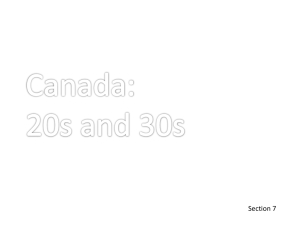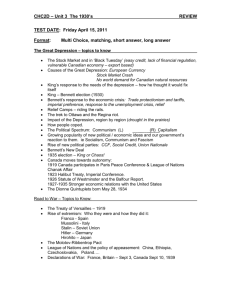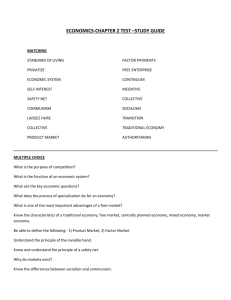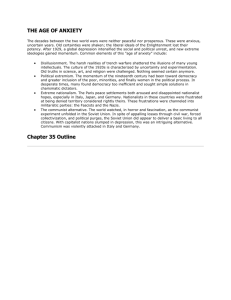Unit 7 Cloze Notes (DOC)
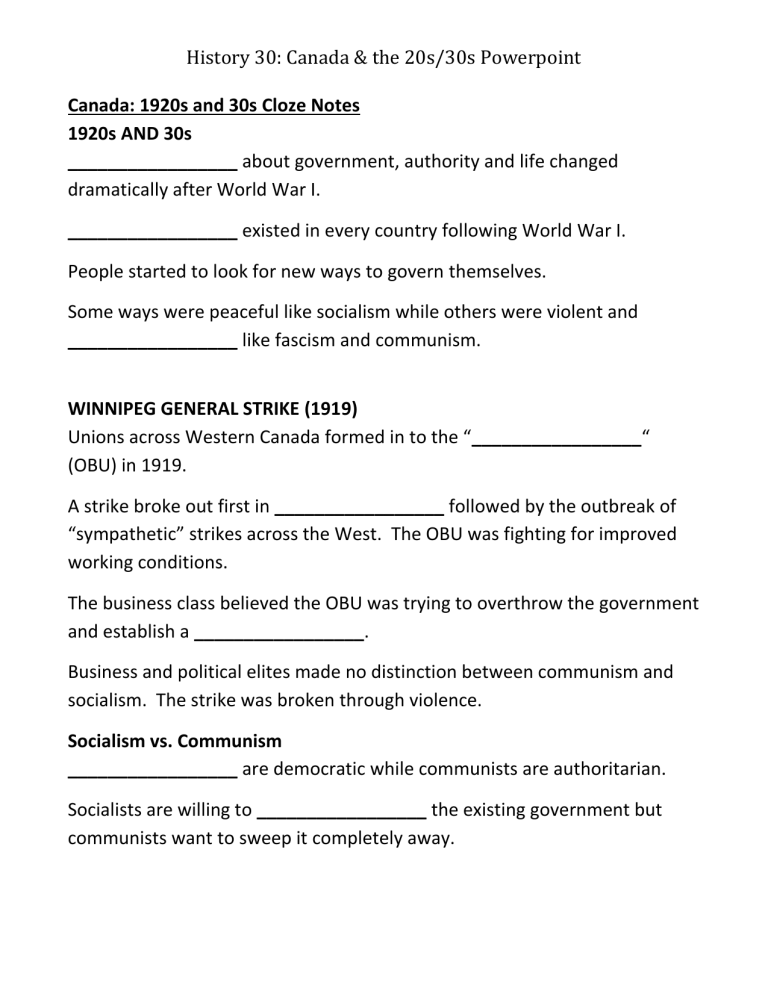
History 30: Canada & the 20s/30s Powerpoint
Canada: 1920s and 30s Cloze Notes
1920s AND 30s
_________________ about government, authority and life changed dramatically after World War I.
_________________ existed in every country following World War I.
People started to look for new ways to govern themselves.
Some ways were peaceful like socialism while others were violent and
_________________ like fascism and communism.
WINNIPEG GENERAL STRIKE (1919)
Unions across Western Canada formed in to the “_________________“
(OBU) in 1919.
A strike broke out first in _________________ followed by the outbreak of
“sympathetic” strikes across the West. The OBU was fighting for improved working conditions.
The business class believed the OBU was trying to overthrow the government and establish a _________________.
Business and political elites made no distinction between communism and socialism. The strike was broken through violence.
Socialism vs. Communism
_________________ are democratic while communists are authoritarian.
Socialists are willing to _________________ the existing government but communists want to sweep it completely away.
History 30: Canada & the 20s/30s Powerpoint
STOCK EXCHANGE COLLAPSES (1929)
In 1929, the _________________ “crashed” starting a global “depression”.
Depression: a sustained, long-term _________________ in economic activity in one or more economies.
The NYSE lost 90% of its value; it took 25 years for the stock exchange to regain its 1929 value.
The Cause
1). Banks allowed investors to buy stocks “_________________”, i.e. you put down 10% of your own money and borrowed to pay for the rest (through a loan).
2). On Oct. 24, 1929, the amount of daily trade inexplicably tripled. Bankers bought stock to prop up their value. Investors panicked dumping their stock.
The value of stock dropped with the drastic drop in _________________.
Supply: the _________________ of a given product available to consumers at a given time.
Demand: a consumer’s desire and willingness to pay a certain price for a specific good or service.
The Supply-Demand Relationship: the relationship between the price of a good and the available quantity of the good demanded.
3). When the stock market crashed bankers called in their loans. The stock used to purchase these loans was now worthless. Since people bought “on margin” they lost money they never even had in the first place.
4). People sold their businesses, life savings, homes, etc. and were bankrupted in an attempt to pay off these bad loans.
History 30: Canada & the 20s/30s Powerpoint
5). The banking system became _________________, i.e. millions of people had no money and lost confidence in the economy. Also, banks refused to loan money to people because of the risk.
Consumer Confidence: the degree of _________________ consumers have for the overall state of the economy and their personal financial situation.
How confident people feel about stability of their incomes determines their spending activity and therefore serves as one of the key indicators for the overall shape of the economy.
THE GREAT DEPRESSION 1929-39
The _________________ started with the stock market crash.
-unemployment: 25-33%
-international trade: down 50%
The Great Depression contributed to unemployment, starvation and political stability. The Canadian Government refused to intervene in the economy.
They argued the market was simply going through a “_________________”.
Correction: one of many inevitable _________________ in the value of stock expected to occur in the financial sector after which a _________________
(or upturn) of the economy is expected.
Governments in the 19 th century operated under the philosophy known as either classical liberalism or _________________.
Laissez-faire: the doctrine that government should _________________ in the commercial affairs of a nation.
Thus, the government sat back waiting for the depression to end; but the
Great Depression did not end. People started to wonder if
History 30: Canada & the 20s/30s Powerpoint
_________________ and _________________ had simply failed. They started looking to alternatives like _________________ and
_________________.
Capitalism: an economic and political system in which a country's trade and industry are controlled by private owners for _________________.
Fascism: an authoritarian and _________________ right-wing system of government and social organization.
Communism: a political theory advocating _________________ leading to a society in which all property is publicly owned and each person works and is paid according to their abilities and needs.
By 1935 governments started introducing new _________________ like minimum wage laws, maximum hours, sick benefits, etc.
Government _________________ (socialism) like this was a radical departure from the “liberal” approach of the past. Good government used to be one that gave virtually absolute freedom to individuals. During the Great
Depression good governments were ones that regulated the economy passing laws to protect citizens.
RISE OF THE DICTATORS (1930s)
The Great Depression and the political instability following World War I led to the emergence of new types of _________________ and
_________________.
History 30: Canada & the 20s/30s Powerpoint
Communism
_________________ of USSR
(1930)
Fascism
_________________ dictator of Italy (1930)
_________________ of Nazi Germany (1933)
_________________ of Spain (1936)
These dictators hated _________________ and _________________. They had no respect for the _________________. They _________________ murdering/imprisoning anyone who opposed them.
Without exception each dictator believed individuals existed solely for the benefit of the state. The role of the citizen was to _________________ and serve that authority. All of these dictators stressed the importance of having a _________________.
For legitimacy both communism and fascism relied upon encouraging either a fear or hatred of enemies. In the case of fascists, they stressed the
“_________________” the state. In the case of communism, they stressed the “_________________” of the state.
Political Legitimacy: the _________________ of a governing law or regime
(government) as actually possessing true (legitimate) authority.
Governments which rely exclusively upon coercion and force for acceptance would be considered “_________________”.
Both fascists and communists relied upon _________________ to force people in to agreement.
History 30: Canada & the 20s/30s Powerpoint
QUESTIONS
Chapter 10
1). List and explain three causes of the Great Depression.
2). How did King and Bennett initially respond to the Great Depression?
3). In what sense was Bennett’s “New Deal” (1935) a departure from the policies of previous governments when it came to dealing with economic uncertainty?
4). How did the Depression (1929-1939) affect political movements in
Canada?
